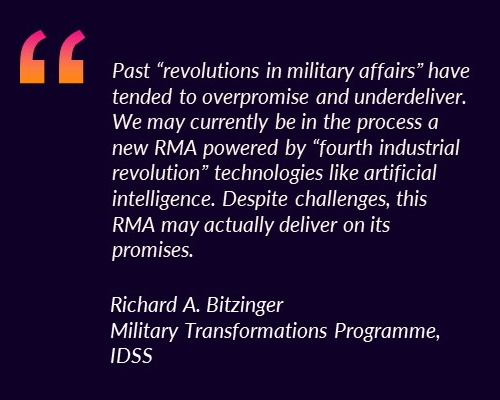Richard Bitzinger

RSIS Commentary is a platform to provide timely and, where appropriate, policy-relevant commentary and analysis of topical and contemporary issues. The authors’ views are their own and do not represent the official position of the S. Rajaratnam School of International Studies, NTU. These commentaries may be reproduced with prior permission from RSIS and due recognition to the author(s) and RSIS. Please email to Mr Yang Razali Kassim, Editor RSIS Commentary at RSISPublications@ntu.edu.sg.
SYNOPSIS
Past “revolutions in military affairs” have tended to overpromise and underdeliver. We may currently be in the process a new RMA powered by “fourth industrial revolution” technologies like artificial intelligence. Despite challenges, this RMA may actually deliver on its promises.
COMMENTARY
THE BASEBALL player/philosopher Yogi Berra once said: “It’s tough to make predictions, especially about the future.” Yet it is the burden of analysts to at least attempt prognostication. In this case especially, defence analysts and experts are often compelled to extrapolate from trendlines in military innovation to basically predict future developments.
Few chores are more difficult. The past is littered with failed predictions, and so it is easy to become jaded and cynical. Yet, when it comes to envisaging future advances in military innovation – and, subsequently, future areas of military capability and advantage – few requirements are more critical. We care about “revolutions in military affairs” (RMAs), because we ignore them at our peril. It is doubly difficult when we realise that we are not only attempting to predict RMAs but to actualise them as well.
RMAs and Central Role of Technology
RMAs are, of course, much more than “mere” technology. RMAs also entail “innovative operational concepts” and “organisational adaptation,” executed in a such a way as to fundamentally alter the character and conduct of warfighting and produce a significant increase in the military potential and effectiveness of armed forces. Above all, an RMA is supposed to be a process of discontinuous and disruptive change in modes of warfare.
Nevertheless, technology and technological innovation is what we always come back to. Mostly this is because technological advances are central to implementing the organisational, operational, and doctrinal aspects of the RMA.
The RMA advanced by “transformationauts” in the 1990s and 2000s was predicated on the so-called the third industrial revolution (3IR) – the information revolution in which we exist and operate today.
(The first industrial revolution, which began in the late 18th century, was the age of steam and iron, exemplified by the first mechanised industries, railroads, telegraph, and the like; this was superseded in the late 19th century by the second industrial revolution, the age of steel, oil, electricity, and the internal combustion engine.)
The 3IR began roughly in the early 1950s with the invention of the transistor and integrated circuitry, leading seamlessly to the microchip, personal computers, wireless communications, and the internet.
This information-technologies (IT) RMA was supposed to deliver military superiority in three ways: information dominance, the networking of military forces, and long-range precision-strike. Sadly, the IT-RMA overpromised and undelivered. In particular, there was no great disruptive change in how militaries fight, but rather a cautious, evolutionary process of change.
Enter 4IR: AI & Offensive Combat Systems
Now we supposedly stand on the cusp of a fourth industrial revolution (4IR), comprising artificial intelligence (AI) and machine-learning, man-machine interfacing, automation and robotics, quantum computing, and the “Internet of Things” (IoT).
AI, together with quantum computing, can assist humans when it comes to collecting, processing, and interpreting the large amounts of data being collected by new and more capable sensors, in order to help produce actionable intelligence.
The IoT and the cloud, in turn, permit data to be safely stored and accessed from anywhere with Internet access, at any time. As such, the 4IR is about connectivity, permitting users to access vast amounts of data collected from constantly connected sources, powered by AI.
AI and quantum computing could power new sensor technologies and provide the massive computing power necessary to interpret large amounts of data coming in from a wide variety of sensors and other resources, as well as enhancing datalinks that would provide shared situational awareness, ideally in real-time.
Moreover, the 4IR will likely drive further development in the area of offensive combat systems. In particular, AI, combined with autonomous systems, could craft a new breed of armed drones, capable of swarmed and coordinated attacks, and able to operate in uncertain or changing combat environments.
Overall, the 4IR could have a dramatic impact on operational capabilities. As noted by Diego Ruiz Palmer, a NATO special advisor, “advances in precision location, targeting and strike, navigation, large data transmission and discrimination, and weapon-system range and manoeuvrability, as well as the growing importance of the outer space and cyber domains” are collectively altering “the spatial dimensions” of warfare.
The Futurist’s Caveats: Domain of the Few
There still exist high barriers to spin-on, especially in countries with weak military R&D infrastructures. In fact, most militaries are still stuck in the “metal-bashing” second industrial revolution, and even the digital revolution of the 3IR eludes them.
Nor should one expect the 4IR to create immediately “game-changing” weapons that will quickly affect military balances. Progress in AI or other 4IR technologies could eventually result in some impressive breakthroughs, but these will likely take decades for their impacts to be felt.
Nevertheless, smaller states may still be able to cherry-pick the 4IR to gain specific new capacities and, therefore, possible new areas of military benefit and leverage. In particular, the growing ubiquity of unmanned systems, especially armed aerial drones or underwater systems, coupled with deployments like swarming, could create asymmetric advantages for smaller or less-developed militaries.
In this context, the potential of a 4IR-based military contest between China and the United States is increasingly possible, and growing more complex and worrisome. Both countries are keen to exploit the 4IR for military advantage.
Artificial Intelligence-RMA: What We’ve Been Looking For?
Michael Raska, in his recent article on “The Sixth RMA Wave” (Journal of Strategic Studies, November 2020), argues that we are in the midst of a new “artificial intelligence-driven RMA” that differs greatly from previous RMAs. If so, then we might be finally getting the RMA we have been looking for.
In this regard, technology is still a crucial determinant of military effectiveness, and consequently harnessing the latest technology is still critical to military success and advantage. And if we are indeed, in a 4IR, then we must be prepared to identify and harness its promise and power.
About the Author
Richard A. Bitzinger is a Visiting Senior Fellow with the Military Transformations Programme at the S. Rajaratnam School of International Studies (RSIS), Nanyang Technological University (NTU), Singapore.

No comments:
Post a Comment